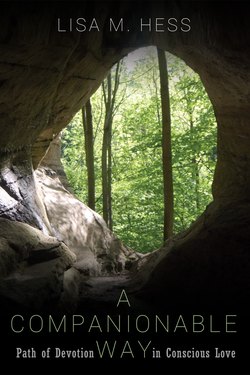A Companionable Way

Реклама. ООО «ЛитРес», ИНН: 7719571260.
Оглавление
Lisa M. Hess. A Companionable Way
A Companionable Way
Table of Contents
Preface (How to Read this Book)
Acknowledgments
In Search of . .
Introduction
Grounding in Exile
Desire
Deep Roots in Difference
Liturgical Hospitality
Belief amidst Nontheism and Other
Path of Conscious Love
Fidelity in the Fear of Betrayal
Devotion
Befriending Outsiders
Seeing With the Heart
Rebirthing
Awakening
Deepening—Into the Dark of Initiation
A New-Old Sacred
Circle
Conclusion
Bibliography
Отрывок из книги
Path of Devotion in Conscious Love
Lisa M. Hess
.....
Imagine our mutual surprise when the first year of his congregational calling ejected me into exile, a nameless space outside of our previously shared, sacred work. I landed again and again in spaces not immediately or obviously assured of sacred intention, at least as we had been trained to conceive of it. Over months, then years, I landed and grew to trust this Holy more and more deeply in a web of companionships of practice and observance, including Tibetan Buddhists, Jews of Conservative, Modern Orthodox, and Hasidic hue, practitioners of earth-centered spirituality (and those faithful to One they call Goddess), atheists, “nones,” and more. Without expectation or conscious intention for it, in these ways and spaces, persons and places, I discovered a depth of devotion to Jesus as Risen Lord as I traveled with and was nourished by those outside my tradition. The felt sense of this Jesus in the power of the Spirit still overwhelms me today. The felt sense and multiple-tradition receivings of it, however, mean mono-traditional language could never adequately describe it. Solely Christian-communal terms are simply insufficient. In an odd, counterintuitive conviction, I grew to trust Jesus so thoroughly to show up “on the other side” that I learned “He” was always there, the Christ-within Who needs no name within wordless devotion.
So what is a woman of faith to do when she senses the sacred, the Holy One, outside of her community’s “boxes,” more often outside her community of faith where she is Led than within its previous bounds or language? Leave church?3 Contrary to any expectation of leaving, all this led to unexpected leadership—elected roles in church and liturgical-curricular leadership in seminary and guild contexts of higher theological education. As each invitation to lead arrived, I discerned them with my multiply-traditional “community of faith,” which had fewer Christians in it by that time. All of us knew leadership was the path to share what I was learning from the peripheries, at the intersections, back into “the center” of my own Christian communion. I accepted the invitations, confirmed mostly by “outsiders.” Still, all along, a sense of dissonance grew—fears of disloyalty, even betrayal—right alongside incontrovertible fruit of Spirit and blessed assurance.
.....